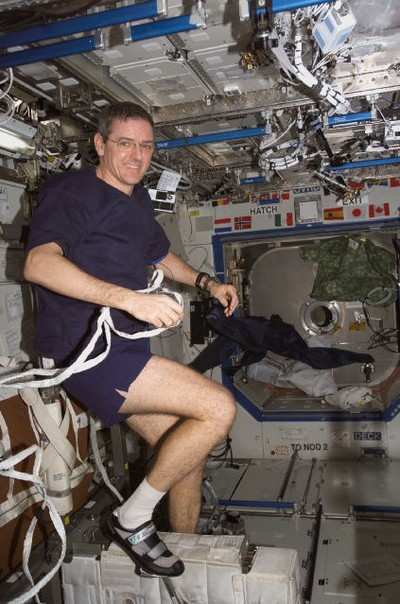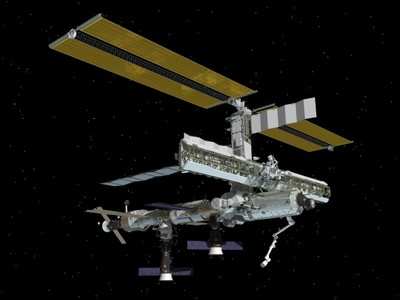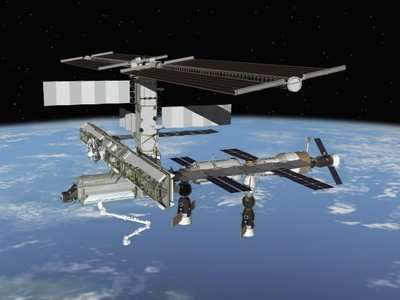Sun, Jan 22, 2006
2006 Report #3, 10:30 a.m. CST, Friday, Jan. 20, 2006
Expedition 12 Commander Bill McArthur began his week Sunday by
running a marathon in space.

McArthur ran a half-marathon on the station treadmill to support
friends and colleagues who ran in the Houston Marathon that day.
McArthur circled the globe at an altitude of 220 statute miles as
runners on the ground circled Houston.
On Tuesday and Wednesday, McArthur and Flight Engineer Valery
Tokarev participated with the ground flight control teams to
rehearse procedures that would be used in the event a rapid cabin
air leak required a station evacuation. Similar emergency
procedures are practiced regularly by all station crews.
McArthur and Tokarev are also preparing for their second
spacewalk. On Thursday, Mission managers decided to delay the
spacewalk from Feb. 2 to Feb 3. The extra time will ease the crew's
preparation schedule. Mission Control sent the crew detailed
procedures for the spacewalk this week, and the crew reviewed the
plans with experts on the ground. In addition, the crew began
charging batteries and preparing the Pirs Docking Compartment
airlock for the excursion. For the spacewalk, McArthur and Tokarev
will wear Russian Orlan-M spacesuits.

During the spacewalk, the crew will move a cargo boom adapter
from one module to another, install a safety bolt into a cable
cutter on the Mobile Transporter truss rail car, and deploy
SuitSat, an old Orlan space suit equipped with an active amateur
radio transmitter. The SuitSat will remain in orbit for several
weeks and allow contact with amateur radio operators on the
ground.
Science operations this week included powering on a European
Space Agency experiment known as Protein Crystal Growth Monitoring
by Digital Holographic Microscope for the International Space
Station (PROMISS-4). McArthur spent several hours setting up the
Microgravity Science Glovebox and other support equipment early in
the week. He then began sample processing for the PROMISS
experiment in the glove box on Thursday. The experiment will
investigate the growth processes of proteins during weightless
conditions using advanced imaging methods such as digital
holography.

McArthur and Tokarev took time out from their duties on Friday
to answer questions posed by students at the Kuss Middle School in
Fall River, Mass.
More News
Aero Linx: Florida Antique Biplane Association "Biplanes.....outrageous fun since 1903." That quote really defines what the Florida Antique Biplane Association (FABA) is all about.>[...]
Beyond Visual Line Of Sight (BVLOS) The operation of a UAS beyond the visual capability of the flight crew members (i.e., remote pilot in command [RPIC], the person manipulating th>[...]
Also: ForeFlight Upgrades, Cicare USA, Vittorazi Engines, EarthX We have a number of late-breaking news highlights from the 2024 Innovation Preview... which was PACKED with real ne>[...]
“For Montaer Aircraft it is a very prudent move to incorporate such reliable institution as Ocala Aviation, with the background of decades in training experience and aviation>[...]
Maximum Authorized Altitude A published altitude representing the maximum usable altitude or flight level for an airspace structure or route segment. It is the highest altitude on >[...]
 ANN's Daily Aero-Linx (04.13.24)
ANN's Daily Aero-Linx (04.13.24) ANN's Daily Aero-Term (04.13.24): Beyond Visual Line Of Sight (BVLOS)
ANN's Daily Aero-Term (04.13.24): Beyond Visual Line Of Sight (BVLOS) Airborne 04.09.24: SnF24!, Piper-DeltaHawk!, Fisher Update, Junkers
Airborne 04.09.24: SnF24!, Piper-DeltaHawk!, Fisher Update, Junkers Aero-News: Quote of the Day (04.14.24)
Aero-News: Quote of the Day (04.14.24) ANN's Daily Aero-Term (04.14.24): Maximum Authorized Altitude
ANN's Daily Aero-Term (04.14.24): Maximum Authorized Altitude





